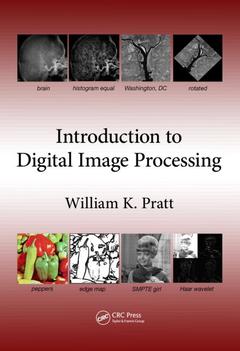Introduction to Digital Image Processing
Auteur : Pratt William K.

The subject of digital image processing has migrated from a graduate to a junior or senior level course as students become more proficient in mathematical background earlier in their college education. With that in mind, Introduction to Digital Image Processing is simpler in terms of mathematical derivations and eliminates derivations of advanced subjects. Most importantly, the textbook contains an extensive set of programming exercises for students.
The textbook examines the basic technologies needed to support image processing applications, including the characterization of continuous images, image sampling and quantization techniques, and two-dimensional signal processing techniques. It then covers the two principle areas of image processing: image enhancement and restoration techniques and extraction of information from an image. It concludes with discussions of image and video compression.
- Covers the mathematical representation of continuous images and discrete images
- Discusses the psychophysical properties of human vision
- Analyzes and compares linear processing techniques implemented by direct convolution and Fourier domain filtering
- Details restoration models, point and spatial restoration and geometrical image modification
- Includes morphological image processing, edge detection, image feature extraction, image segmentation, object shape analysis, and object detection
- Describes coding technique applicable to still image and video coding based upon point and spatial processing
- Outlines the widely adopted JPEG and MPEG still image and video coding standards
The author?s accessible style provides historical background on the development of image processing techniques as well as a theoretical exposition. The inclusion of numerous exercises fully prepares students for further study.
Continuous Image Characterization: Continuous Image Mathematical Characterization. Psychophysical Vision Properties. Photometry and Colorimetry. Digital Image Characterization: Image Sampling and Reconstruction. Image Quantization. Discrete Two-Dimensional Linear Processing: Discrete Image Mathematical Characterization. Superposition and Convolution. Unitary and Wavelet Transforms. Linear Processing Techniques. Image Improvement: Image Enhancement. Image Restoration. Geometrical Image Modification. Image Analysis: Morphological Image Processing. Edge Detection. Image Feature Extraction. Image Segmentation. Shape Analysis. Image Detection and Registration. Image and Video Compression: Point Processing Image Compression. Spatial Processing Image Compression. Video Compression. Appendices. Annexes. Bibliography. Index.
Date de parution : 10-2013
15.6x23.4 cm
Thèmes d’Introduction to Digital Image Processing :
Mots-clés :
RGB Color Image; Continous Image Characterization; RGB Color; Digital Image Characterization; RGB Color Space; Discrete Two-Dimensional Linear Processing; RGB Image; Image Improvement; JPEG Baseline; Image Analysis; Haar Transform; Spectral Energy Distribution; Ωx Ωy; RGB; Impulse Response; Tristimulus Values; Huffman Code; Wavelet Transforms; Wavelet Transform; Image Restoration; AC Coefficient; DC Coefficient; Color Coordinate System; Karhunen Loeve Transform; Destination Image; Image Coding System; Impulse Response Function; Quantized Coefficients; JPEG Lossless



